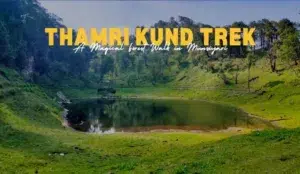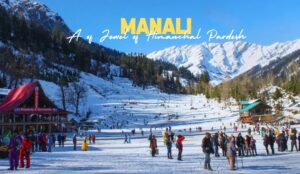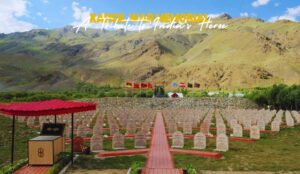“Discover the Hidden Gem of Malari Village 🏞️ | Uncover Serenity in Malari’s Charm | Your Ultimate Malari Guide 🌄”
About Malari Village:
Location: Malari Village is located in the Indian state of Uttarakhand, in the northern part of the country. It is situated in the Chamoli district of Uttarakhand, which is part of the Himalayan region. Malari Village is known for its scenic beauty and is often used as a base for treks and expeditions in the surrounding mountains, including those in the Nanda Devi Biosphere Reserve.
Please note that conditions and accessibility to remote areas like Malari Village can change, so it’s a good idea to check with local authorities or travel resources for the most up-to-date information if you plan to visit.
Geography: Situated at an altitude of approximately 3,600 meters (11,800 feet) above sea level, Malari offers breathtaking views of the surrounding Himalayan peaks.
Culture: The village is inhabited by the indigenous Bhotia tribe, known for their unique culture and traditions, adding to the village’s rich heritage.
Biodiversity: Malari is renowned for its diverse flora and fauna, making it a paradise for nature enthusiasts and wildlife lovers.
History of Malari Village:
- Ancient Origins: Malari has a history dating back centuries, with evidence of human settlement found in the region. It served as a trade route connecting India and Tibet.
- Trade Hub: In the past, Malari played a crucial role in facilitating trade between India and Tibet, serving as a significant trading post for various goods.
- Cultural Heritage: The village has preserved its cultural heritage over the years, with traditional customs, music, and dance forms being an integral part of daily life.
- Natural Disasters: Malari Village has also faced its share of challenges, including natural disasters like floods and avalanches, which have shaped its history and resilience.
- Tourism: In recent years, Malari has gained attention as a trekking destination, attracting adventure seekers and trekkers due to its proximity to the Nanda Devi peak.
These points provide a comprehensive overview of Malari Village and its historical significance.
Facts about Malari Village:
- Remote Himalayan Location: Malari Village is situated in the remote reaches of the Indian Himalayas, making it one of the most secluded and pristine destinations in Uttarakhand.
- Altitude: At an elevation of approximately 3,600 meters (11,800 feet) above sea level, Malari is among the highest permanently inhabited villages in the region.
- Bhotia Heritage: Malari is inhabited predominantly by the Bhotia tribe, known for their distinct culture, language, and architectural style, which is evident in the village’s unique buildings.
- Natural Beauty: The village offers breathtaking views of snow-capped Himalayan peaks, lush meadows, and pristine rivers, making it a haven for nature enthusiasts and photographers.
- Flora and Fauna: Malari’s surroundings are rich in biodiversity, with various species of Himalayan flora and fauna, including rare and endangered species, thriving in the region.
- Historical Significance: Malari served as an important trade route between India and Tibet for centuries, and its history is intertwined with the trade of goods, such as salt, wool, and spices.
- Cultural Treasures: The village’s cultural heritage is exemplified through its traditional dances, music, and festivals, which provide visitors with a glimpse into the unique Bhotia way of life.
- Trekking Destination: Malari has gained popularity as a base for treks to the Nanda Devi Sanctuary and the Valley of Flowers National Park, offering adventurers the chance to explore pristine wilderness.
- Challenges and Resilience: Over the years, Malari has faced challenges like natural disasters, including floods and landslides, but the resilient community has consistently rebuilt and preserved their village.
- Limited Accessibility: Due to its remote location, reaching Malari can be an adventure in itself, involving long journeys through rugged terrain, which adds to its allure for intrepid travelers.
These facts highlight the uniqueness and allure of Malari Village, making it a captivating destination for those seeking a blend of culture, history, and natural beauty in the heart of the Himalayas.
Why Malari Village is Famous:
- Gateway to Nanda Devi Biosphere Reserve: Malari Village is renowned for being the gateway to the Nanda Devi Biosphere Reserve, a UNESCO World Heritage site and one of the most pristine and ecologically significant regions in the Himalayas.
- Trekking Paradise: It’s famous among trekkers and adventure enthusiasts as a starting point for treks to the Nanda Devi Sanctuary, Milam Glacier, and the Valley of Flowers, offering some of the most challenging and rewarding trekking experiences in India.
- Natural Beauty: Malari’s stunning natural beauty, surrounded by towering Himalayan peaks and lush meadows, makes it a magnet for nature lovers, photographers, and artists seeking inspiration.
- Cultural Richness: The village’s unique Bhotia culture, traditional architecture, and warm hospitality draw cultural enthusiasts and anthropologists interested in exploring indigenous Himalayan communities.
- Wildlife Viewing: The region around Malari is home to diverse wildlife, including the elusive snow leopard, musk deer, and various species of Himalayan birds, making it a prime spot for wildlife enthusiasts.
Things to Do in Malari Village:
- Trekking Expeditions: Embark on epic treks to Nanda Devi Base Camp, Milam Glacier, and Valley of Flowers, guided by experienced local trekking guides who can navigate the challenging terrain.
- Explore Bhotia Culture: Immerse yourself in the rich Bhotia culture by visiting local homes, participating in traditional dance and music sessions, and trying authentic Himalayan cuisine.
- Photography and Sightseeing: Capture breathtaking landscapes and village life, with opportunities for photography at every turn. Don’t miss the iconic views of the Nanda Devi peak.
- Wildlife Safari: Go on a wildlife safari to spot rare Himalayan wildlife in the surrounding forests, with the possibility of encounters with snow leopards, Himalayan tahr, and more.
- Visit Religious Sites: Explore the ancient temples and monasteries in and around Malari, such as the Narayan Ashram, offering spiritual experiences and architectural wonders.
- Camping and Stargazing: Set up camp in the picturesque meadows surrounding the village and enjoy stargazing sessions to witness the clear night skies of the Himalayas.
- River Rafting: For the adventurous, try white-water river rafting on the Alaknanda River, which flows near Malari, providing thrilling experiences against the backdrop of pristine landscapes.
- Local Handicrafts: Support the local economy by purchasing handmade Bhotia handicrafts, textiles, and traditional artifacts as souvenirs.
Malari Village is a multifaceted destination that offers a blend of adventure, culture, and natural beauty, making it a must-visit for travelers seeking authentic Himalayan experiences.
Things to Know about Malari Village:
- Remote Location: Malari Village is situated in the Chamoli district of Uttarakhand, India, in the Garhwal region. It’s known for its remote and secluded location, offering a tranquil escape from urban life.
- Altitude: The village is located at an altitude of approximately 3,600 meters (11,800 feet) above sea level, making it one of the highest inhabited villages in the region.
- Weather: Malari experiences a cold and harsh climate, with winters being extremely cold and snowy, while summers are relatively mild.
- Local Culture: The predominant population in Malari is of the Bhotia tribe, known for their unique culture and traditions.
- Accommodation: Accommodation options in Malari are limited, primarily consisting of guesthouses and homestays run by locals.
- Limited Connectivity: Malari has limited mobile network coverage and internet connectivity, providing an opportunity to disconnect and enjoy the serenity of the Himalayas.
How to Reach Malari Village:
- By Air: The nearest airport to Malari is the Jolly Grant Airport in Dehradun, approximately 330 kilometers away. From there, you can hire a taxi or take a bus to reach Joshimath, the nearest major town.
- By Road: Malari can be reached by road from Joshimath, which is connected to major cities in Uttarakhand and nearby states. The journey from Joshimath to Malari involves a challenging drive through mountainous terrain.
- Trekking: Trekkers can access Malari by undertaking various trekking routes that pass through the region, such as the Nanda Devi Base Camp Trek and the Milam Glacier Trek. These treks provide a more adventurous route to the village.
- Permits: It’s essential to obtain the required permits to visit Malari Village, especially if you plan to trek to restricted areas like Nanda Devi Sanctuary. Permits can be obtained in Joshimath or through authorized agencies.
- Local Transport: Once in Joshimath, you can hire local taxis or shared vehicles to reach Malari Village. The journey may take several hours, depending on road conditions.
- Trekking Season: If you plan to trek to Malari, the best time to visit is during the summer months (May to June) and the post-monsoon season (September to October) when the weather is relatively stable.
Visiting Malari Village requires careful planning and preparation due to its remote location and challenging accessibility, but the rewards are unmatched in terms of natural beauty and cultural experiences.
Travel Tips for Malari Village:
- Prepare for Altitude: Given the high altitude of Malari Village, it’s crucial to acclimatize properly. Spend a day or two in Joshimath or another lower-altitude location before heading to Malari to avoid altitude sickness.
- Pack Warm Clothing: Malari experiences cold temperatures, even during the summer. Bring warm clothing, including layers, a good-quality jacket, gloves, and a hat to stay comfortable.
- Essential Medications: Carry essential medications and a first-aid kit, as medical facilities in the area are limited. Consult your doctor regarding altitude sickness prevention medication if necessary.
- Cash and ATMs: There are no ATMs in Malari, so withdraw sufficient cash in Joshimath or another larger town before heading to the village.
- Local Customs: Respect the local culture and traditions of the Bhotia community. Seek permission before taking photographs of individuals and their property.
- Permits: Ensure you obtain any required permits for trekking or visiting restricted areas. Check the latest permit regulations with local authorities or tour agencies.
- Food and Water: While basic meals are available in Malari, it’s a good idea to carry some non-perishable snacks and a reusable water bottle.
- Local Guides: Hiring a local guide for trekking and exploring the area is advisable. They possess valuable knowledge of the terrain, weather, and can enhance your overall experience.
- Communication: Mobile network coverage is limited in Malari. Inform friends or family about your travel plans and expected return dates.
Best Time to Visit Malari Village:
- Summer (May to June): This is the best time to visit Malari Village for pleasant weather and clear skies. Trekking conditions are optimal during this period, with blooming flowers adding to the scenic beauty.
- Post-Monsoon (September to October): After the monsoon rains have subsided, September and October offer another excellent window to visit. The landscapes are still lush, and the weather is relatively stable.
- Winter (Late November to April): Winter brings heavy snowfall and extremely cold temperatures, making it less suitable for most travelers. However, it may appeal to those seeking a snowy, off-season adventure.
- Monsoon (July to August): Monsoon season should be avoided due to heavy rainfall, landslides, and challenging trekking conditions. Many routes may be inaccessible during this time.
Choosing the best time to visit Malari Village largely depends on your interests and tolerance for different weather conditions. Summer and early autumn are generally the most popular and enjoyable periods for most visitors.
Places to Eat Near Malari Village:
- Local Homestays and Guesthouses: Many local homestays and guesthouses in Malari Village offer homemade meals prepared with fresh, local ingredients. This is an excellent opportunity to savor authentic Bhotia cuisine.
- Tea Stalls and Small Eateries: You can find small tea stalls and eateries in and around Malari, offering basic snacks, tea, and simple meals like dal (lentil soup) and rice.
- Joshimath: As the nearest town to Malari, Joshimath has a wider range of dining options. You can find restaurants and dhabas (roadside eateries) serving North Indian, Tibetan, and Garhwali dishes.
- Auli: Auli, a popular skiing destination near Malari, has a few restaurants and cafes where you can enjoy a variety of cuisines. It’s a great place to relax and refuel after a day of adventure.
- Rishikesh and Haridwar: If you’re traveling from further away, Rishikesh and Haridwar offer diverse dining options, including international cuisine, vegetarian fare, and street food. These towns are well-connected to Malari by road.
Nearby Places to Explore from Malari Village:
- Joshimath: Located approximately 50 kilometers from Malari, Joshimath serves as a base for many treks and offers attractions like the Kalpavriksha tree and Adi Badri Temple.
- Auli: Just a short distance from Malari, Auli is famous for its skiing opportunities in winter and the scenic cable car ride that offers panoramic views of the Himalayas.
- Badrinath: About 68 kilometers from Malari, Badrinath is one of the Char Dham pilgrimage sites and is known for the Badrinath Temple, surrounded by stunning mountains.
- Nanda Devi National Park: Explore the pristine wilderness of Nanda Devi National Park, accessible via trekking routes from Malari Village.
- Valley of Flowers: Discover the vibrant and colorful Valley of Flowers National Park, a UNESCO World Heritage site, located a trek away from Malari during the summer months.
- Rishikesh and Haridwar: If you’re up for a longer journey, you can visit Rishikesh and Haridwar, known for their spiritual significance, yoga centers, and adventure activities like river rafting.
- Mana Village: Known as the last Indian village near the Tibetan border, Mana Village is worth a visit for its unique cultural and geographical significance.
Exploring these nearby places allows you to delve deeper into the rich culture, natural beauty, and adventure opportunities of the Garhwal Himalayas while savoring different culinary experiences along the way.
Conclusion:
Malari Village, nestled in the pristine Himalayan landscapes of Uttarakhand, India, is a captivating destination that offers a unique blend of natural beauty, cultural richness, and adventure. Its remote location, at an altitude of approximately 3,600 meters, ensures a tranquil escape from the hustle and bustle of urban life. Visitors are treated to breathtaking views of snow-capped peaks, lush meadows, and the warm hospitality of the Bhotia tribe, who have preserved their traditions for generations.
Whether you’re an adventure enthusiast seeking challenging treks, a nature lover captivated by diverse flora and fauna, or a cultural explorer keen to experience the unique Bhotia way of life, Malari Village has something to offer. To make the most of your trip, plan ahead, respect local customs, and choose the best time to visit based on your preferences. Malari Village promises an unforgettable journey into the heart of the Himalayas.
FAQs (Frequently Asked Questions) about Malari Village:
Is Malari Village accessible year-round?
Malari Village is accessible year-round, but the best time to visit is during the summer (May to June) and post-monsoon (September to October) months when the weather is most favorable for outdoor activities.
Are permits required to visit Malari Village?
Yes, permits may be required, especially for trekking and visiting restricted areas like the Nanda Devi Sanctuary. It’s essential to check permit regulations with local authorities or tour agencies.
What should I pack for a trip to Malari Village?
Pack warm clothing, including layers, a jacket, gloves, and a hat, as well as essential medications, a first-aid kit, and cash, as there are no ATMs in Malari.
What are the must-visit places near Malari Village?
Nearby attractions include Joshimath, Auli, Badrinath, Nanda Devi National Park, Valley of Flowers, and Mana Village, each offering a unique experience and natural beauty.
How do I reach Malari Village from major cities?
You can reach Malari by road from Joshimath, which is accessible by bus or taxi from major cities like Dehradun. Alternatively, you can trek to Malari from nearby trekking routes.





